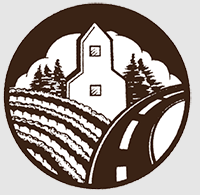Ghost Hill
Caution! We do not provide turn-by-turn directions in our GPX files. Those are auto-generated by your bike computer and are usually less than 70% accurate. Learn more.
For help loading a GPX file onto your bike computer, go here.
DownloadHighlights & Remarkable Spots
East Carlton
This sector is dominated by orchards and vineyards with a touch of farmlands and woodlands. The roads are quiet. The riding is moderate; rolling hills and flats except for one climb, the Woodlands loop [miles 11.5 to 16.5].
You may be tempted to skip the loop, but don’t! It gives some great valley views, the climbing is moderate [4 to 5% on paved], and the downhill is zippy fast. Low traffic.
West Carlton
This sector is more rolling and punchy; the terrain is more of ranchlands, timberlands, and woodlands than vineyards and orchards.
At ~mile 22, you pass by an orchard of dead and decaying filbert trees; the Eastern Filbert Blight has infected them. We encourage you to take a moment to learn more about this challenge that farmers face; the trade-off between growing high-end filbert trees used in chocolate confections where the highest prices are fetched and trees that are more resistant to blight but provide a less superior product.
A bit after this, you will see Bailey Nurseries on your left, a fifth-generation, family-owned company in business since 1905 with multiple divisions in Oregon, Washington, Illinois, and Minnesota. Bailey Nurseries is a top-five producer of trees and shrubs nationwide.
Mile 26.5 marks the beginning of the Old Railroad Grade road that parallels the North Yamhill River, one of our favorite sectors of this ride. It is a quiet road that follows the river for just under 5 miles through big trees dripping with moss.
At ~mile 31 is the most demanding pitch of the day, the Timberlands Double Bump. It is a stair-stepped climb through an actively managed forest (for logging) that climbs at 8 to 12% for 1.5 miles.
The last 2 to 3 miles will have a bit more traffic. For your safety, we recommend riding single file and using a red blinky light.
When We Like to Ride This
The Willamette Valley area rides well most of the year. Winter can be wet, but spring is absolutely beautiful with the flowers, blooming trees, green fields, and flowing creeks.
Terrain & Riding
We like this route for what it is and isn’t. It is rural Oregon, a mix of hay/alfalfa fields, filbert orchards, vineyards, ranchlands, and logging. The route provides a unique and close insight into Oregon culture and history; a place that was the terminus for many who traveled the Oregon trail in the 1800s. Overall, the route is quite moderate; it doesn’t beat you up, nor grind you down!
The Start
Upper City Park in Carlton. Flush toilets.
Food & Water
- ~ Mile 17.5: Yamhill (you will need to deviate from the route slightly and continue into Yamhill).
Route Notes
40 mm tires are a good choice for the terrain. Some riders may be inclined to go narrower.
Expect some traffic on both the paved and gravel roads. This is just a fact of the route being at the urban-rural interface and Portland being a close, a large metro area. Riding with a red blinky light is recommended. We like those with a rear-looking radar detector.
Also, please remember that these roads (both paved and gravel) are the lifelines to ranching, farming, and logging during the week. Allow yourself to be a respectful visitor by making it easy for farm tractors and logging trucks to pass you. Thus, we recommend that you limit your group size to 6 or less, keep your group tight fore to aft and single-file if being overtaken by a truck/tractor, and if on a narrow one-lane road, stop and put a foot down to let the truck/tractor pass.
Route Options
Other rides in the area to consider are:
- Yamhill Loop / 5 Star Route
- Yamhill 8 / Development Route
- Ghost Hill / 5 Star Route
- G-Man / Development Route
- McMinnville Mayhem / Development Route
- Powerhouse / 5 Star Route
- Chehalem Vineyard Tour / Development Route
From this collection of routes, you can build longer and more challenging routes, but you can also shorten routes to your liking. See our 20 Minutes series on “How to Modify Routes with RideWithGPS“.




























 Behind every route is scouting, mapping, storytelling, and a whole lot of pedal power.
Behind every route is scouting, mapping, storytelling, and a whole lot of pedal power.
Have you ridden this route? Got a question? Join the discussion!